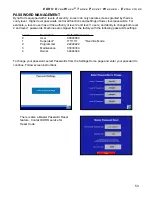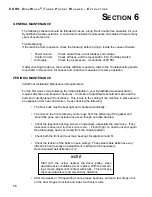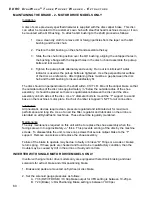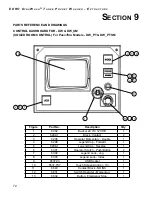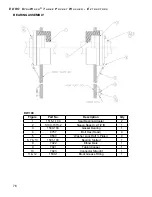
E D R O
D
y n a
W
a s h
®
T
h r e e
P
o c k e T
W
a s h e r
- e
x T r a c T o r s
61
Lubrication
Bearings are pre-lubricated. No additional lubricant is required for start-up. As a precaution, if
the equipment is to be left idle for any extended period of time prior to actual use, the bearings
should be filled 100% full to provide maximum protection from corrosion.
The specific conditions on an application such as exact hours of operation, temperature,
moisture, speed and dirt govern the required lubrication cycle. We recommend lubrication of
the bearings every fifty hours of operation. Frequency can also be determined by inspection of
the flushed out lubricant during a trial period of operation. Use a sufficient volume of grease to
purge the bearing seals of old lubricant. It is preferable to rotate bearings during re-lubrication
where good safety practice permits. Use the same number of strokes on the rear bearing as on
the front bearing.
Inspection of bearing installations at least every six (6) months is recommended. Any unusual
noise or vibration change should be immediately investigated.
MAINTAINING THE BEARINGS
NOTE
Suggested starting interval for maintenance program.
Check grease condition for low viscosity and dirt and adjust
greasing frequency accordingly. Watch operation
temperatures. Sudden rises may show need for grease or
indicate over lubrication. Use grade #2, high temperature,
water resistant, lithium grease.
Removal
Front Bearing: remove bearing cover, and grease line from grease fitting. Rear Bearing:
remove belt guard, belts and flywheel. Proceed by removing mounting bolts and place them
into existing tapped holes on the bearing flange. Use bolts to jack bearing from bearing adapter.
When bearing does not move freely, use a puller.
Installation
Check to make sure the shaft is clean and free of burrs and nicks. Coat the shaft and bearing
bore with grease or oil to facilitate assembly. If it is necessary to tap or press units on the shaft,
use a hardwood block, soft steel bar or tube against the end of the inner ring. DO NOT EXERT
PRESSURE ON HOUSING OR SEALS. Bolt bearings securely to the bearing adapter. Use
Grade 5 mounting bolts adjusted to the proper torque. Establish final shaft position and secure
locking collar to the fixed bearing and shaft. Tighten collar set screws to the torque values given
in table below. Rotate shaft slowly, under load if possible, for several revolutions to properly
center the roller elements with respect to the raceways. Securely tighten collar set screws.
NOTE
Any condition of strain, irregular rotational torque,
abnormal sound or vibration may be due to improper
alignment, improper location, bent shaft, etc. Installation
should be rechecked and corrections made as required.







